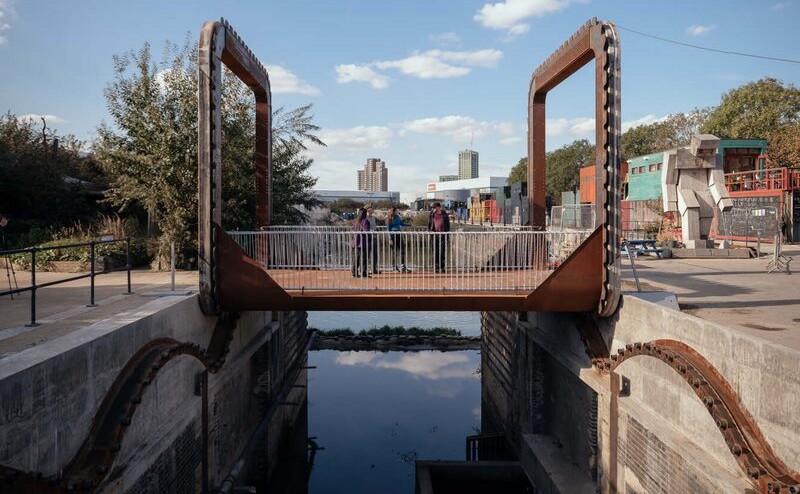
The crown jewel in a recent revitalization project of a London industrial area is a “rolling bridge” made of squares powered by a hand crank.
The bizarre spectacle of two large squares gradually inverting the deck of the pedestrian footpath to allow boats to pass underneath a canal lends the new Cody Docks community in London a touch of Victorian-era chic tinged with steampunk madness.
Architect Thomas Randall-Page freely admits it’s not possible to justify everything about the square rolling bridge. It could have been cheaper, it could have been powered by hydraulics or electricity, or it could have been a much simpler design.
But its childish fun, its imaginative function nestled perfectly within its surroundings leaves Randall-Page believing it to be exactly what Cody Docks needs as it transitions from an old 19th-century industrial wharf where the Thames meets the tidal River Lea to a creative community.
Reopening the dock to the Lea’s waters required the removal of a dam and the introduction of a footbridge over a canal where barges would pass into a refurbished mooring.
“To move it from one position to another takes about 20 minutes,” says Randall-Page calmly. “It was important to have that manual aspect, partly because it’s a very low-energy solution in terms of you’re not relying on external power solutions, and partly because there’s a way in which that simplifies things; there’s a whole lot less that can go wrong.”
“If something does begin to go wrong you notice it, you literally feel it getting harder to move. So it’s kind of a haptic check-in process,” he said in a micro-doc about his bridge.
MORE BIZARRE ENGINEERING PROJECTS: Girl Surprised With Pet Dragon After Surviving Cancer and Making-a-Wish – ‘It’s a Marvel of Engineering’
For someone wondering how the square portals of the bridge roll, it’s because they’re mounted on rails built into the sides of the canal wall which undulate up and down like hills on the horizon. This symmetry allows the whole bridge structure to smoothly roll through 180 degrees to a fully inverted position facilitating the movement of boats from the river to the dock.
Randall-Page said his design was inspired by a visit to a friend’s boat. At times, he had to help his friend pass through canal locks, and the architect took an immediate liking to the low-tech yet smart and hands-on Victorian design of the lock mechanism.
JUST LIKE THIS: The World’s First Boat Elevator Helped Turn Scottish Canals Into Green Veins of Joy
“There’s something very nice about being able to look at the thing even if it’s stationary, and kind of be able to read something about how it works,” he said. Everything’s on show, the winches are on show, the tracks are on show, and if you’ve got your head screwed on you can follow the logic of how this thing works.”
WATCH the mini-doc below…
SHARE This Truly Unique Project With Your Friends…



















